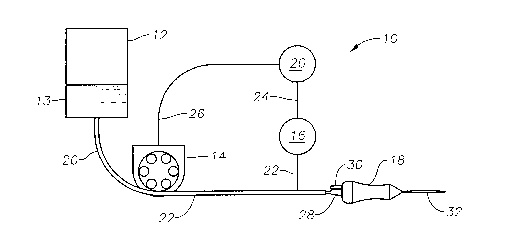Some of the information on this Web page has been provided by external sources. The Government of Canada is not responsible for the accuracy, reliability or currency of the information supplied by external sources. Users wishing to rely upon this information should consult directly with the source of the information. Content provided by external sources is not subject to official languages, privacy and accessibility requirements.
Any discrepancies in the text and image of the Claims and Abstract are due to differing posting times. Text of the Claims and Abstract are posted:
| (12) Patent Application: | (11) CA 2607593 |
|---|---|
| (54) English Title: | REFLUX CONTROL IN MICROSURGICAL SYSTEM |
| (54) French Title: | CONTROLE DU REFLUX DANS UN SYSTEME MICROCHIRURGICAL |
| Status: | Deemed Abandoned and Beyond the Period of Reinstatement - Pending Response to Notice of Disregarded Communication |
| (51) International Patent Classification (IPC): |
|
|---|---|
| (72) Inventors : |
|
| (73) Owners : |
|
| (71) Applicants : |
|
| (74) Agent: | KIRBY EADES GALE BAKER |
| (74) Associate agent: | |
| (45) Issued: | |
| (86) PCT Filing Date: | 2006-04-13 |
| (87) Open to Public Inspection: | 2007-01-04 |
| Examination requested: | 2011-03-04 |
| Availability of licence: | N/A |
| Dedicated to the Public: | N/A |
| (25) Language of filing: | English |
| Patent Cooperation Treaty (PCT): | Yes |
|---|---|
| (86) PCT Filing Number: | PCT/US2006/014066 |
| (87) International Publication Number: | US2006014066 |
| (85) National Entry: | 2007-10-29 |
| (30) Application Priority Data: | ||||||
|---|---|---|---|---|---|---|
|
An improved method of controlling reflux in a microsurgical system involving
monitoring reflux pressure over time to detect occlusion break.
Méthode améliorée de contrôle du reflux dans un système microchirurgical impliquant la surveillance de la pression de reflux au fil du temps, pour détecter toute rupture d~occlusion.
Note: Claims are shown in the official language in which they were submitted.
Note: Descriptions are shown in the official language in which they were submitted.

2024-08-01:As part of the Next Generation Patents (NGP) transition, the Canadian Patents Database (CPD) now contains a more detailed Event History, which replicates the Event Log of our new back-office solution.
Please note that "Inactive:" events refers to events no longer in use in our new back-office solution.
For a clearer understanding of the status of the application/patent presented on this page, the site Disclaimer , as well as the definitions for Patent , Event History , Maintenance Fee and Payment History should be consulted.
| Description | Date |
|---|---|
| Application Not Reinstated by Deadline | 2013-10-23 |
| Inactive: Dead - No reply to s.30(2) Rules requisition | 2013-10-23 |
| Deemed Abandoned - Failure to Respond to Maintenance Fee Notice | 2013-04-15 |
| Inactive: Abandoned - No reply to s.30(2) Rules requisition | 2012-10-23 |
| Inactive: S.30(2) Rules - Examiner requisition | 2012-04-23 |
| Letter Sent | 2011-03-22 |
| All Requirements for Examination Determined Compliant | 2011-03-04 |
| Request for Examination Received | 2011-03-04 |
| Request for Examination Requirements Determined Compliant | 2011-03-04 |
| Inactive: Notice - National entry - No RFE | 2008-09-08 |
| Inactive: Cover page published | 2008-01-28 |
| Inactive: First IPC assigned | 2007-11-28 |
| Application Received - PCT | 2007-11-27 |
| National Entry Requirements Determined Compliant | 2007-10-29 |
| Application Published (Open to Public Inspection) | 2007-01-04 |
| Abandonment Date | Reason | Reinstatement Date |
|---|---|---|
| 2013-04-15 |
The last payment was received on 2012-03-22
Note : If the full payment has not been received on or before the date indicated, a further fee may be required which may be one of the following
Patent fees are adjusted on the 1st of January every year. The amounts above are the current amounts if received by December 31 of the current year.
Please refer to the CIPO
Patent Fees
web page to see all current fee amounts.
| Fee Type | Anniversary Year | Due Date | Paid Date |
|---|---|---|---|
| Basic national fee - standard | 2007-10-29 | ||
| MF (application, 2nd anniv.) - standard | 02 | 2008-04-14 | 2008-03-19 |
| MF (application, 3rd anniv.) - standard | 03 | 2009-04-14 | 2009-03-26 |
| MF (application, 4th anniv.) - standard | 04 | 2010-04-13 | 2010-03-22 |
| Request for examination - standard | 2011-03-04 | ||
| MF (application, 5th anniv.) - standard | 05 | 2011-04-13 | 2011-03-18 |
| MF (application, 6th anniv.) - standard | 06 | 2012-04-13 | 2012-03-22 |
Note: Records showing the ownership history in alphabetical order.
| Current Owners on Record |
|---|
| ALCON, INC. |
| Past Owners on Record |
|---|
| KIRK W. TODD |
| MARK A. HOPKINS |